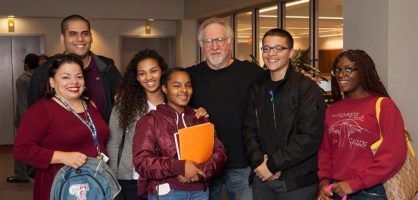By Alexandra Brennan

Students from Fannie Lou High School in the Bronx visited Fordham for a live oral history. (Courtesy of Twitter)
When local archivists enlisted the help of Fordham’s African-American Studies department several years ago to assemble history about the Bronx for schools and community groups, Dr. Mark Naison, professor of African American studies, was uncertain about what the task would entail. The history of The Bronx and its demographics have undergone several shifts, with the Irish, Italian, Puerto Rican and African American populations playing key roles in the formation and history of the borough. It was his own fascination with The Bronx as it used to exist and how it exists today that inspired him to pioneer a course on it entitled: “The Bronx: Immigration Race and Culture.” This past Friday, 30 of his own Fordham students shared in that history with 60 high school students from the Bronx’s Fannie Lou High School.
Aixa Rodriguez, Fordham alumnus and teacher at Fannie Lou High School, became acquainted with Naison after she attended a seminar Naison taught for high school teachers about how to teach a course on Bronx history. Rodriguez talked with her principal and created a Bronx Memoir course for the high school.
Rodriguez and Naison were able to combine forces and to create the Bronx History Collaborative, which is an umbrella term for the two courses they teach and is a representation of what these two Bronx schools are trying to accomplish. “It’s trying to break down the walls between Fordham, and local schools,” said Naison.
Naison began the seminar with an oral history project on the Bronx. The oral history was in part compihed by interviewing residents who were among the first wave of the African-American migration to the Bronx during the 1930s and the first generation to reside in public housing that opened in the 1950s.
However, they happened to stumble upon the many musical genres rooted in the Bronx community, from the jazz scene during the 40s and 50s in the Morrisania neighborhood to the emergence of doo-wop right outside of Fordham’s gates.
Bronx schools were interested in introducing their students to a cultural history of their own borough, and Naison was invited to speak at about 30 Bronx schools.
This visiting system came to a sudden end in 2008 when the New York City Department of Education decided to give letter grades to schools based on test scores, threatening to close schools who didn’t achieve a certain grade and the schools visited were often worried.
The schools temporarily put this learning on hold as a reuslt. By 2014, 168 schools had been closed in total, 60 of them in the Bronx. When New York City elected Mayor Bill DeBlasio, he ended this practice, leaving room for a variation of Naison’s program to continue and for high school students to stay engaged.
Naison then began teaching “The Bronx: Immigration Race and Culture.” “It’s very specifically focused on how immigration and migration has changed the Bronx over the last…100 years,” said Naison.
A student of Naison’s, Kiera Maloney, FCRH ‘17, said Naison’s style of teaching is not like other professors, and has only positive feelings towards his style. “I learned so much but in a totally alternative way,” Maloney said. To immerse themselves in Bronx culture, the students go on walking tours, read books and watch movies. The class also has a variety of speakers, ranging from teachers to rappers.
Before the oral history session occurred, Margaret Curran, FCRH ’17, traveled to Fannie Lou High School to help facilitate a discussion based on what the students have learned from Naison’s class.
Curran became involved in the high school class when she went to Naison’s office hours and asked how Curran could help. Naison put her in contact with Rodriguez, and she has been helping with the class every Thursday since.
“It’s been really exciting,” Curran told The Fordham Ram. “I feel like I’m learning stuff from being in the class.”
As students continued the oral history, Naison stressed the importance of having pride in the Bronx, especially for the high school students who grew up here and continue to live here.
“The mixing of cultures – that’s what makes the Bronx special,” Naison said.
